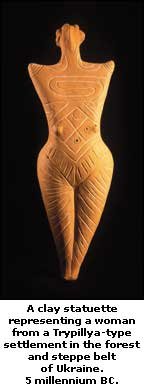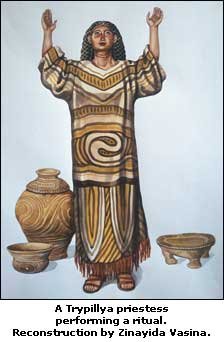Trypillian Civilization 5400 - 2750 BC |
||
***
©2002-2006 |
Trypillian towns 7,000 years oldNadiya Dovzhenko, a historian, tells an amazing
story
of the discovery of the most ancient “towns” in Europe. 
The village of Trypillia in Ukraine is one of many thousands, but for over a hundred years it has been in the focus of attention of archeologists, and not only Ukrainian. The village gave the name to ancient settlements — or rather an ancient culture — the first of which was discovered in the village’s vicinity. The more we learn about the Trypillia culture, the more mysterious this culture begins to look, and some historians even compare it to the mythical Atlantis.
The end of the 19th century was the time when great archeological discoveries were made — Schliemann discovered Troy, Evans revealed the Knossos Palace in Crete to the world; long-forgotten civilizations of the Middle and Near East, and East Mediterranean about whose existence was known only from the writings of ancient historians, or even not known altogether, began to be brought into the history books thanks to the untiring efforts of archeologists and history enthusiasts. Eastern Europe seemed, for some time, to have contributed but little to the development of European civilization in the “prehistoric” times. But in the year 1893 a discovery was made that was to change the historians’ view on the progress of civilization in Eastern Europe, or in fact, in the whole of Europe — a Ukrainian archeologist, V. Khvoyka, who later became one of the founders of the National History Museum of Ukraine, found in an archeological dig remnants of big-sized adobes, shards of ornamented earthenware, statuettes representing women and copper weapons which definitely dated to the times much more ancient that had been previously thought possible. The finds showed that millennia ago the people who lived in this territory tilled the land, knew handicrafts and had some kind of religious beliefs. A little later, another discovery, this time in the vicinity of the village of Trypillia, not far from Kyiv, showed that big settlements, in fact prototowns, existed in Eastern Europe long before any similar settlements came into being in the rest of Europe. The name Trypillia was given to a culture (in English tradition: Cucuteni-Tripolye culture) that existed about three thousand years before the Common Era and that spread over a vast territory of what is now Ukraine — and beyond. Further discoveries made in Moldova and Eastern Rumania showed that the Trypillia civilization stretched over a very large territory and was a phenomenon of all-European importance. 
After the initial discoveries of the nineteenth century, a further line of research was suggested by aerial photographs taken when new detailed maps of the forest and steppe areas of Ukraine in the land of Kyivshchyna and elsewhere in Ukraine were being made. The photographs showed spots on the ground with traces of what might have been ancient human settlements. Archeological excavations proved it was a correct guess — what was discovered amounted not just to individual albeit very big houses but rather to what could be called “prehistoric towns.” These “towns” in Maydanetsky, Dobrovody, Talyanky and Zhvanets had a definite structure like any town, with buildings placed in concentric circles, or forming squares, or parallel lines, or groups. The size of these settlements is one of the things that impresses you most — some of them cover from 150 to 450 hectares (there are 2.5 acres in a hectare). The geography of these “Trypillia” settlements is very wide — from the Dnipro River to the Bug River. Similar sites were found in Moldova as well. Some of the buildings were truly immense — from 300 to 600 meters long, with many rooms. The walls and ceilings were decorated with black and red patterns. The clay beds and other features of the interior were decorated with intricate designs in bright colours. Some of the clay statuettes found in the archeological excavations must have been representations of the people who lived in these huge buildings of the prehistoric towns. The male faces are elongated, deep-set eyes, with prominent noses. So far, not a single statuette representing a woman has been found without a sort of a mask on the face and it is one of the mysteries of the Trypillia culture. The number of male statuettes is very small compared to the great profusion of female statuettes unearthed in the Trypillia settlements — and in all of them the featureless oval of the face or a mask is all we can see. Most of the female statuettes are graceful, long-legged, some are naked, some are garbed in what looks like festive clothes. The reason why they are “faceless” is not clear but it must be connected with some kind of a ritual. A closer study revealed that the “masks” carried representations of sheep, swine, lizards, turtles, snakes and birds — cocks, hens, ducks, storks, hawks and other birds of prey. Why was the face covered when the body was revealed? The close examination of the statuettes showed that the women’s bodies were tattooed in several places, the stomach and the back being the most covered with tattoos. The most popular ornamental designs were spirals, rhombs, meanders — and the Tree of Life. Some of the statuettes still carry signs of black and red colours which indicated details of the clothing. The most popular garment seems to have been the skirt of various lengths with fringes at the hem; aprons were also worn. 
The later stages in the development of the Trypillia culture reveal a change in the style of dress — women must have begun wearing dresses tightly clinging to their bodies; and probably even something like “hot pants.” These close-fitting garments were lavishly decorated with spirals and meanders. The statuettes and pictures on the vases indicate that women also wore high boots, red in colour. The hair was worn in various styles. The representations on the earthen ware and vases show that women’s hair was made either in a sort of the pinned-up, bun style, or was plaited in two braids which were arranged like crowns on their heads. However, the short or combed back styles predominate, with fancier styles probably reserved for some special occasions. It is known that the Trypillia people bred cattle, pigs and horses, and grew wheat, barley and vegetables. Paleobotanists discovered that the Trypillia people had orchards providing them with fruit. The first cheery trees in the territory of Ukraine were cultivated by the Trypillians. Their agriculture was well advanced for their time and they used ploughs to till the land. The Trypillia people used the potter’s wheel and ovens to bake the pottery in. In the village of Vesely Kut (Cheerful Corner — a nice, cheerful indeed name for a village!), remnants of quite sophisticated ovens dating to the Trypillia culture were found. The pottery was of many kinds and many styles, decorated in at least 20 different manners. In the Trypillia settlement of Nebelivka, close to Maydanetsky, the archeologists unearthed what may be regarded as the most ancient set of ceramics in Central and Eastern Europe, with plates, bowls and cups decorated in a similar manner to make them distinctly belonging to one set. The Trypillia “metallurgists” knew alloys, the ones of copper and silver included. In one of the caches, unearthed millennia after it was hidden, 552 objects made of metal were discovered. At the later stages of the Trypillia culture development, fortifications began to be built around the “towns” — earthen walls, stockades and moats. The Trypillia people defended themselves against raids of the more aggressive neighbours engaged in animal husbandry and against the nomads. The archeologists, geophysicists and paleobotanists engaged in the study of the Trypillia culture have discovered that at the latest stages of development of this culture, the ecological situation worsened and it could have been one of the factors that caused the decline and eventual downfall of the Trypillia civilization. But the actual reasons for the disintegration of the Trypillia culture are not yet known. 
It is known though that the tribes that later formed the Trypillia culture must have migrated from the territories of what today are Rumania and Hungary, and settled in the territory of the present-day Ukraine in about the sixth millennium BC. We have no clear evidence as to what language they spoke. The Trypillia culture passed through three distinctive phases of development which have been called Stage A, Stage B and Stage C. At Stage A, the Trypillia dwellings were relatively small, some were dug in the ground. At Stage B, the size of the settlements expanded and the houses grew in size, with some having two floors and many rooms. The Trypillia people knew many handicrafts, including weaving and knitting. At Stage C, the Trypillia people began making sophisticated earthedware but at the same time they started making weapons, both metal and stone. Their religion and cults dealt, in all evidence, with such issues as cosmogony and afterlife. Among the more developed cults were those of Mother Earth, Cult of the Bull, and that of the Fire. The artifacts found in the archeological excavations suggest that the Trypillia people maintained trade with other tribes of Central and Eastern Europe, or may be even spread even further. At the moment we have more questions about the Trypillia culture than answers — but the search goes on and who knows what the next revolutionary discovery will bring.
Photos by Yury Tymochko |
|
| 31.10.2005
<<<Back |
||